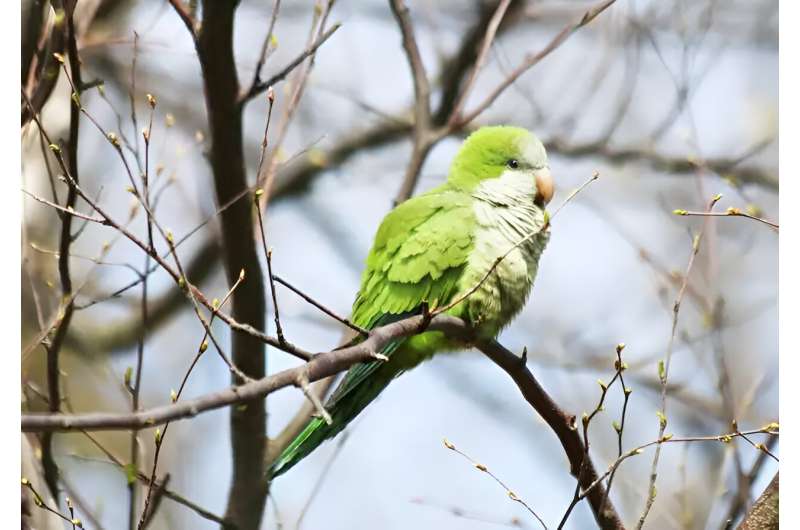This article has been reviewed according to Science X's editorial process and policies. Editors have highlighted the following attributes while ensuring the content's credibility:
fact-checked
peer-reviewed publication
trusted source
proofread
Study is the first to document dialect differences in a parrot across its European range

In the 50 years since monk parakeets arrived in Europe and spread across the continent, the species has developed distinct dialects that vary across countries and cities, according to a team of researchers from the Max Planck Institutes of Animal Behavior in Konstanz and for Evolutionary Anthropology in Leipzig, Germany.
Using a novel analytical method, the scientists compared the calls made by monk parakeets in eight cities across four countries in Europe, finding that the parrots now "sound" different in each city. The work is published in the journal Behavioral Ecology.
"Just like humans, monk parakeets in Europe have unique ways of communicating based on where they live," says lead author Stephen Tyndel, a doctoral student at the Max Planck Institute of Animal Behavior.
Europe doesn't have any native parrot species. However, several species, including the monk parakeet, have established populations after individuals escaped from the pet trade. Originally from South America, monk parakeets now exist in huge numbers in several countries in Europe.
Like all parrots, monk parakeets have an exceptionally flexible vocal repertoire and can imitate and learn new sounds throughout their lives. Because the invasive parrot spread through Europe only recently, says Tyndel, "monk parakeets are the perfect test tube for studying how complex communication evolves in a species other than our own."
To find out if monk parakeets in Europe developed dialects—that is, calls that differ based on where individuals live—researchers recorded monk parakeets in eight cities across Spain, Belgium, Italy, and Greece. A novel statistical method allowed them to test if parrot calls were different from city to city, and also if calls were different among parks within the same city. "We wanted to find out not only if there are different dialects, but at what geographical scale they occur," says Tyndel.
City-specific dialects
They discovered that parrots did have different dialects in each city. Parakeets in Brussels, for example, had contact calls that were particularly different from those of other cities, says co-lead author Simeon Smeele, an affiliate scientist at the Max Planck Institute of Animal Behavior and the Max Planck Institute for Evolutionary Anthropology.
For the most part, dialects differed in the frequency modulation structure within each call, "which is super difficult for humans to hear," adds Smeele.
But when scientists looked for dialects within parks in each city, they found no differences. Parrots did not have unique calls from one park to the next. "Taken together, this suggests that parrot dialects separated early when birds invaded European cities, but then didn't significantly change further over this time period," says Tyndel.
The results were surprising, says Tyndel. "This suggests that dialects came about through a passive process—birds copying birds make small errors and therefore cities slowly become different from each other—or that they were different to begin with, and that these differences were maintained over time."
But the team hasn't ruled out that dialects might also be formed by an active process that could help birds with social communication, such as recognizing group mates. In parks, monk parakeets live in nests that are highly clustered. The researchers think there might be vocal differences, like slang, in these smaller social units.
"We think that dialects could be used to communicate who is part of what nest cluster, like a password," says Smeele. In the future, the team plans to find out how individuals learn from each other and if smaller groups show dialects within parks.
"This will add to our understanding of parrot communication," says Tyndel, "and provide insights into the ways in which complex communication is linked to the complex social lives of humans and animals."
More information: Simeon Q Smeele et al, Multilevel Bayesian analysis of monk parakeet contact calls shows dialects between European cities, Behavioral Ecology (2023). DOI: 10.1093/beheco/arad093
Journal information: Behavioral Ecology
Provided by Max Planck Society


















